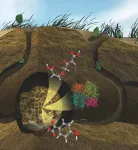(Press-News.org) A research team led by Nebraska scientists has built the largest-ever metabolic model of corn to study how temperature stress affects the plant and how a certain fungus can help alleviate the problem.
The research is an expansion of earlier work with a metabolic model of corn roots that the same team used to study the plant’s nitrogen-use efficiency under nitrogen stress conditions, said Rajib Saha, Richard L. and Carol S. McNeel associate professor of chemical and biomolecular engineering and principal investigator. Saha and the team have expanded the model to comprise the entire plant, not just the roots, allowing for expanded research into the intricate metabolic interactions, their associated molecular underpinning and a variety of stressors that can affect productivity.
The metabolic model is of corn hybrid B73, whose genome is highly prized for making hybrids that are used for food, feed and a variety of industrial uses. Developed at Iowa State University in the early 1970s, this line and its descendants are present in half the parentage of nearly all hybrid corn grown around the world.
The Nebraska-developed multi-organ metabolic model — the largest ever created of corn (or any other plant) — allows scientists to conduct research more efficiently and quickly than field research using actual corn plants. The model can also help field researchers with actual corn plants conduct experiments faster and more efficiently, said Niaz Bahar Chowdhury, a doctoral student working with Saha.
It’s estimated that temperature stress resulting from climate change can reduce corn productivity by 7% to 18%.
“There is a pressing need to develop high-yielding maize genotypes capable of withstanding temperature stress,” Saha said.
Scientists are focusing on how plants’ metabolism can be adjusted to counteract that stress. The team’s study takes a holistic, plant-wide approach rather than looking only at specific elements of the plant, Saha said.
Among other impacts, temperature stress can reduce photosynthesis and carbohydrate synthesis in leaves, reduce starch synthesis in kernels, and affect amino acids and lignin biosynthesis in stalks. Also, temperature stress can damage enzymes and tissues, impair flowering and trigger oxidative stress at the reproductive stage.
Saha’s team expressed excessive heat and cold data into their model, finding that both created so-called “metabolic bottlenecks” that slowed plant growth, but noting that heat was especially problematic. Excessive heat is expected to continue impeding crop growth amid ongoing climate change.
One approach to mitigate temperature stress is to reengineer the plant, creating new hybrids that are less affected by it. While that can be successful, “it’s a very, very long process,” Saha said.
In the other approach, researchers inoculated corn root with a beneficial fungus known as Rhizophagus irregularis, commonly used as a soil inoculant. The new study found that R. irregularis also was successful in reducing metabolic bottlenecks that slow plant growth under heat and cold stress conditions, Saha said. Both whole plant biomass and organ-specific biomass growth rates increased with the fungal treatment. Future research, using the same metabolic model, will focus on how R. irregularis affects plant metabolism under high- and low-nitrogen conditions.
Chowdhury and Saha said the model they have created will be available to researchers who want to study other stresses on corn.
The research, funded by the National Science Foundation and Department of Energy, is summarized in an article in iScience. Co-authors include researchers from Iowa State and Pennsylvania State universities, along with Université Paris-Saclay, INRAE, AgroParisTech, Institut and Centre de Versailles-Grignon, and Institut National de Recherche pour l’Agriculture in France.
END
Husker researchers using metabolic model to study temperature stress on corn
A research team led by Nebraska scientists has built the largest-ever metabolic model of corn to study how temperature stress affects the plant and how a certain fungus can help alleviate the problem.
2024-02-02
ELSE PRESS RELEASES FROM THIS DATE:
New prescription drugs typically sold first in US
2024-02-01
Most new prescription drugs are sold first in the U.S. before they reach other nations, but ultimately important medications are sold across most wealthy nations within about a year of first sale, according to a new RAND report.
Researchers say the study’s findings have implications for the debate over whether efforts to reduce high prescription costs in the U.S. could hurt patients’ access to the newest drug treatments.
“Other wealthy nations -- all of which have much lower drug prices compared ...
Social inequity is linked to lower use of epidural in childbirth
2024-02-01
In a study of women in labor in the U. S., social inequity was associated with lower use of neuraxial analgesia -- an epidural or spinal pain reliever-- among non-Hispanic White women and, to a greater extent, among African American women, according to research at Columbia University Mailman School of Public Health and Columbia Vagelos College of Physicians and Surgeons (P&S). The results are published online in Obstetrics & Gynecology.
Neuraxial analgesia, which can be a combined spinal and epidural ...
For World Cancer Day, Alliance for Cancer Care Equity advocates to ‘close the care gap’ as observance is honored with congressional resolution
2024-02-01
WASHINGTON, D.C. [February 1, 2024] — For World Cancer Day, the National Comprehensive Cancer Network® (NCCN®), American Cancer Society Cancer Action Network (ACS CAN), and the National Minority Quality Forum (NMQF) are announcing three key areas of policy focus as part of the Alliance for Cancer Care Equity (ACCE) joint collaboration, including advancing diversity in clinical trials, improving cancer screening and early detection, and increasing access to patient navigation. The organizations are also working with Congresswoman Terri Sewell (D-AL) to observe the day with a congressional ...
Applications open for School of Hologenomic Data Analysis For Agriculture
2024-02-01
The São Paulo School of Advanced Science on Hologenomic Data Analysis for Agriculture (Hologenome School) will be held from July 29 to August 09, 2024, in São Carlos (São Paulo state, Brazil) at the EMBRAPA Southeastern Livestock, Embrapa Instrumentation, decentralized units of the Brazilian Agricultural Research Corporation (EMBRAPA), and at the University of São Paulo’s Chemistry Institute of São Carlos (IQSC-USP).
Hologenome School will provide students and young researchers with an interdisciplinary view of hologenomics and state-of-the-art ...
Insulin prices in US are nine times higher than in other wealthy nations, study finds
2024-02-01
The gross price of insulin in the U.S. is more than nine times higher than in 33 high-income comparison nations, according to a new RAND report.
Although the cost differences of insulin between the U.S. and other nations varied depending on the comparison country and the type of insulin, U.S. prices were always higher -- often five to 10 times higher -- than those in other countries. The new report updates findings from earlier RAND work about U.S. insulin prices.
After accounting for rebates and other discounts often offered by drug manufacturers, the price of a unit of insulin remained 2.3 times higher in the ...
Diabetes and liver cancer — Stanford Medicine study suggests new screening guidelines
2024-02-01
For centuries, doctors have used their hands as essential diagnostic tools — exploring joints and palpating abdomens to assess a patient’s health. Often a cancer will reveal itself as a lump or unusual stiffness in a normally bouncy tissue or organ.
More recently, the relationship between stiffness and cancer has been documented through biophysical studies and clinical trials, particularly in liver and breast cancer. For example, stiffness is a primary hallmark of liver cirrhosis, which can progress to liver cancer.
Now researchers ...
Researchers take new ‘mixed reality’ headsets for a spin
2024-02-01
Among the buzziest consumer technologies right now are “mixed reality” or “spatial computing” headsets that convincingly blend views of the real world with digital content.
A key enabling technology behind these gizmos is passthrough video, which involves blocking out all light so users must rely on cameras on the headsets to see the external world around them via real-time video playing on tiny screens. The arrangement allows users to physically interact with their environments and go about daily activities but with added digital content displayed, ranging from familiar device apps to innovative gaming scenarios. ...
How leafcutter ants cultivate a fungal garden to degrade plants and provide insights into future biofuels
2024-02-01
By Maegan Murray
Scientists have spent decades finding ways to efficiently and affordably degrade plant materials so that they can be converted into useful bioproducts that benefit everyday life.
Bio-based fuels, detergents, nutritional supplements, and even plastics are the result of this work. And while scientists have found ways to degrade plants to the extent needed to produce a range of products, certain polymers such as lignin, which is a primary ingredient in the cell wall of plants, remain incredibly difficult to affordably break down without adding pollutants back into the environment. These polymers can be left behind as waste products with ...
UC Davis establishes bird flight research center
2024-02-01
Researching how bird flight can inform aircraft design is the goal of a new center to be established at the University of California, Davis.
Christina Harvey, an assistant professor of mechanical and aerospace engineering at UC Davis, and Michelle Hawkins, a professor in the School of Veterinary Medicine and director of the California Raptor Center, are launching the bird flight research center with a nearly $3 million grant from the Department of Defense. The new center will utilize motion capture and photogrammetry ...
ADA releases updated recommendations to enhance radiography safety in dentistry
2024-02-01
CHICAGO, Feb. 1, 2024 – The use of lead abdominal aprons or thyroid collars on patients when conducting dental X-rays is no longer recommended, according to an expert panel established by the American Dental Association (ADA) Council on Scientific Affairs. Additionally, dentists should take into consideration the diagnostic information needed from X-rays to benefit patient care or substantially improve clinical outcomes.
The Journal of the American Dental Association published the new recommendations today, which aim to improve radiation ...
LAST 30 PRESS RELEASES:
New software sheds light on cancer’s hidden genetic networks
UT Health San Antonio awarded $3 million in CPRIT grants to bolster cancer research and prevention efforts in South Texas
Third symposium spotlights global challenge of new contaminants in China’s fight against pollution
From straw to soil harmony: International team reveals how biochar supercharges carbon-smart farming
Myeloma: How AI is redrawing the map of cancer care
Manhattan E. Charurat, Ph.D., MHS invested as the Homer and Martha Gudelsky Distinguished Professor in Medicine at the University of Maryland School of Medicine
Insilico Medicine’s Pharma.AI Q4 Winter Launch Recap: Revolutionizing drug discovery with cutting-edge AI innovations, accelerating the path to pharmaceutical superintelligence
Nanoplastics have diet-dependent impacts on digestive system health
Brain neuron death occurs throughout life and increases with age, a natural human protein drug may halt neuron death in Alzheimer’s disease
SPIE and CLP announce the recipients of the 2025 Advanced Photonics Young Innovator Award
Lessons from the Caldor Fire’s Christmas Valley ‘Miracle’
Ant societies rose by trading individual protection for collective power
Research reveals how ancient viral DNA shapes early embryonic development
A molecular gatekeeper that controls protein synthesis
New ‘cloaking device’ concept to shield sensitive tech from magnetic fields
Researchers show impact of mountain building and climate change on alpine biodiversity
Study models the transition from Neanderthals to modern humans in Europe
University of Phoenix College of Doctoral Studies releases white paper on AI-driven skilling to reduce burnout and restore worker autonomy
AIs fail at the game of visual “telephone”
The levers for a sustainable food system
Potential changes in US homelessness by ending federal support for housing first programs
Vulnerability of large language models to prompt injection when providing medical advice
Researchers develop new system for high-energy-density, long-life, multi-electron transfer bromine-based flow batteries
Ending federal support for housing first programs could increase U.S. homelessness by 5% in one year, new JAMA study finds
New research uncovers molecular ‘safety switch’ shielding cancers from immune attack
Bacteria resisting viral infection can still sink carbon to ocean floor
Younger biological age may increase depression risk in older women during COVID-19
Bharat Innovates 2026 National Basecamp Showcases India’s Most Promising Deep-Tech Ventures
Here’s what determines whether your income level rises or falls
SCIE indexation achievement: Celebrate with Space: Science & Technology
[Press-News.org] Husker researchers using metabolic model to study temperature stress on cornA research team led by Nebraska scientists has built the largest-ever metabolic model of corn to study how temperature stress affects the plant and how a certain fungus can help alleviate the problem.




